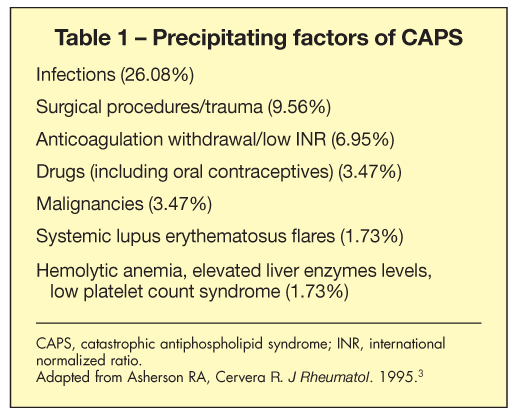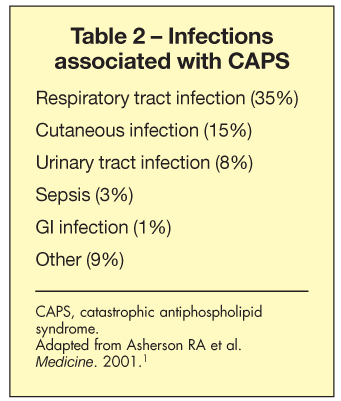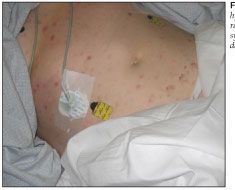Catastrophic Antiphospholipid Syndrome in Secondary Syphilis
Catastrophic antiphospholipid syndrome (CAPS), first described by Asherson and colleagues1 in 1992, refers to a clinical scenario in which multiple vascular occlusive events involving small vessels that supply blood to organs occur over a short period.
Key words: Secondary syphilis, Catastrophic antiphospholipid syndrome
Catastrophic antiphospholipid syndrome (CAPS), first described by Asherson and colleagues1 in 1992, refers

to a clinical scenario in which multiple vascular occlusive events involving small vessels that supply blood to organs occur over a short period. CAPS represents more than 1% of all cases of antiphospholipid syndrome (APS), which itself was first described by Hughes2 in 1983 and was defined as a constellation of venous or arterial thrombotic events, recurrent episodes of fetal loss, and moderate throm

bocytopenia in association with the presence of antiphospholipid (aPL) antibodies. Analysis of the precipitating factors of CAPS shows that the most remarkable factor is infection, occurring at a rate of 26% (Table 1).1,3 The infections most associated with CAPS are respiratory, followed by cutaneous (Table 2).1
The discovery of aPL antibodies occurred in the early 1900s during efforts to develop blood tests for syphilis.4 It was found that reagin, a substance in the blood of patients with syphilis, binds to extracts within various kinds of tissue.4 In the early 1940s, it was discovered that a negatively charged phospholipid (ie, aPL) in these extracts reacts with reagin.4 Secondary syphilis is a disease that is relatively prevalent in the world, but the incidence of it as a precipitating factor of CAPS has not been reported.
Case report
A 56-year-old white woman presented to the emergency department complaining of shortness of breath with associated chills, vomiting, and a hyperpigmented macular rash on her palms and abdomen. The patient did not recall a past diagnosis of syphilis, and her family history was negative for coagulopathies. She denied having allergies. She had abused cocaine, marijuana, and alcohol since the early 1980s.
The shortness of breath had persisted for 10 days, progressively worsened over the past 2 days, and became unbearable a few hours before presentation. A ventilation-perfusion scan showed a high probability of multiple pulmonary emboli. Rapid plasma reagin test results were positive for syphilis. The finding was confirmed by fluorescent treponemal antibody-absorption testing. Pulmonary embolism and secondary syphilis were diagnosed.
Blood tests revealed an international normalized ratio (INR) of 1.2, prothrombin time of 16.2 seconds, partial thromboplastin time (PTT) of 39.8 seconds, and IgM anticardiolipin antibody levels of more than 100 MPL. The patient was intubated, given heparin, and admitted to the ICU.
Doppler ultrasonography of the lower extremities revealed deep venous thrombosis (DVT) in the left common femoral and left popliteal and great saphenous veins bilaterally. CT of the abdomen and pelvis also was performed with and without contrast and revealed a hypodensity in the right kidney.
After 2 days in the ICU, the patient was extubated. Three days later, she exhibited an altered mental status. A CT scan of the head without contrast revealed a large right middle cerebral artery (MCA) infarction with complete left-sided paralysis and slurred speech. A CT scan of the thorax exhibited a bilateral pulmonary embolism (PE). The patient was subsequently admitted to the ICU and intubated. She remained on ventilator support in the ICU for another week.
Penicillin G, 2.4 million units intramuscularly once a week for 3 weeks, was administered for treatment of secondary syphilis. The patient was transferred to the step-down unit and remained there for another 2 weeks. A follow-up CT scan of the thorax showed an extension of the right PE into the right lower and middle and upper lobe segments along with a continued left lower lobe segment PE. It was also noted that new-onset cardiomegaly had developed. A goal INR of more than 3.0 was achieved with warfarin 7.5 mg/d. After 4 weeks, the patient was transferred to the physical rehabilitation unit.
The patient remained in the rehabilitation unit for 20 days during which time she began to walk; however, shortness of breath developed again along with chest pain, nausea, vomiting, diaphoresis, and dizziness, even though her INR was maintained at greater than 3.0. The troponin I level was 13.17 ng/mL, with a non–ST-segment elevation myocardial infarction (NSTEMI) on the ECG.
The IgM anticardiolipin antibody level was 25 MPL units, and the IgG level was 49 GPL units. A cardiac catheterization that was performed the following day revealed normal coronary anatomy, suggesting that thrombus formation had caused the NSTEMI. Warfarin was discontinued and heparin restarted. The PTT levels were again very difficult to stabilize, fluctuating from 33 to 96 seconds, with an average shift of 10 seconds a day.
The performance of PTT measurements was stopped. Heparin (anti-Xa) levels, with a goal range of 0.6 to 0.7 U/mL, were measured. Intravenous immunoglobulin (IVIG) therapy was initiated as a continuous infusion of 25 g/d for 5 days. The patient refused high-dose corticosteroid therapy at that time. IgM and IgG anticardiolipin antibody levels, which were measured 2 days after completion of IVIG therapy, decreased to 16 MPL units and 31 GPL units, respectively.
The patient’s therapy was switched to subcutaneous enoxaparin sodium injection. She was discharged 10 days after the NSTEMI and was provided with home physical therapy. She was closely followed up and continues to do well.

Figure –Shown is a hyperpigmented macular rash indicative of secondary syphilis in the patient described in this case.
Discussion
Primary syphilis, which commonly appears as an asymptomatic chancre in women, usually presents 9 to 90 days after initial infection. Secondary syphilis typically occurs 2 months after primary syphilis. Approximately 90% of patients with secondary syphilis present with hyperpigmented macular or papular lesions on the abdomen, palms, or soles (Figure). Generalized lymphadenopathy, constitutional symptoms, and mucosal lesions may accompany the cutaneous lesions.
The treatment for early-stage primary and secondary syphilis is 1 dose of penicillin G, 2.4 million units. In later-stage disease, this dose is given once a week for 3 weeks.5 Doxycycline may be substituted if the patient is allergic to penicillin.5 Although secondary syphilis is relatively common-and although test results for serum antibodies to reagin are positive in virtually all patients with secondary syphilis-it is remarkable that CAPS has previously not been found to be associated with this disease.
CAPS can affect the microvasculature and macrovasculature of veins and arteries. The incredible amount of thrombus formation occurs very suddenly, affecting 3 or more organ systems within days to weeks, with a 50% mortality rate. The criteria for the diagnosis of this syndrome are outlined in Table 3. Patients are considered to have definite CAPS if they fulfill all 4 diagnostic criteria. Patients are considered to have probable APS if they meet all 4 criteria but only have involvement of 2 organs or systems, if they meet all 4 criteria but have only a single positive determination for aPL, or if they meet the first and last criteria but meet only 1 of the 2 middle criteria.6
Our patient presented with a PE, bilateral DVT formation in the lower extremities, and a partial infarction of the right kidney. Within a week, a large, right MCA infarction developed. Four weeks later, NSTEMI with a troponin I level of 13.17 ng/mL and normal coronaries were documented. Both IgM and IgG anticardiolipin antibody levels that were far above the normal reference values decreased after treatment.
A retrospective study conducted by Khamashta and colleagues7 concluded that anticoagulant therapy that results in an INR above 3.0 provides better protection against recurrence of APS than does less intense therapy. A goal INR of 3.0 was not sufficient to prevent further coagulation in this patient in light of NSTEMI after having received warfarin for 4 weeks. The astonishingly high levels of circulating aPL continuously obscured her PTT levels, compelling us to begin measuring anti-Xa levels on a daily basis to acquire more accurate measurements.
Several treatment strategies exist for APS. Most experts prefer the use of multiple plasmapharesis, high-dose corticosteroids, IVIG, or all 3 therapies.8 Support for these approaches are anecdotal but justifiable because of the high mortality rate associated with CAPS.8 Our patient had refused high-dose corticoste-roid therapy and plasmapharesis but was willing to receive IVIG therapy. IVIG both inhibits the aPL and inactivates the idiotype-bearing B cell clones, resulting in a decrease in autoantibody production.9 CAPS should be considered in anyone with secondary syphilis in whom signs and symptoms that are not associated with classic manifestations of syphilis develop.
References:
REFERENCES
1. Asherson RA, Cervera R, Piette JC, et al. Catastrophic antiphospholipid syndrome: clues to the pathogenesis from a series of 80 patients. Medicine (Baltimore). 2001;80:355-377.
2. Hughes GR. The Prosser-White oration 1983. Connective tissue disease and the skin. Clin Exp Dermatol. 1984;9:535-544.
3. Asherson RA, Cervera R. Review: antiphospholipid antibodies and the lung. J Rheumatol. 1995;22:62-66.
4. Roubey RA. Lab tests for antiphospholipid antibodies: What are they? What do they mean? Lupus News. 2001;3:21.
5. Gilbert DN, Moellering RC Jr, Eliopoulos GM, Sande MA. The Sanford Guide to Antimicrobial Therapy 2005. 35th ed. Hyde Park, VT: Antimicrobial Therapy Inc; 2005:15-16.
6. Asherson RA, Cervera R, de Groot PG, et al. Catastrophic antiphospholipid syndrome: international consensus statement on classification criteria and treatment guidelines. Lupus. 2003;12:530-534.
7. Khamashta MA, Cuadrado MJ, Mujic F, et al. The management of thrombosis in the antiphospholipid-antibody syndrome. N Engl J Med. 1995;332:993-997.
8. Lockshin MD, Erkan D. Treatment of the antiphospholipid syndrome. N Engl J Med. 2003; 349:1177-1179.
9. Sherer Y, Levy Y, Shoenfeld Y. Intravenous immunoglobulin therapy of antiphospholipid syndrome. Rheumatology (Oxford). 2000;39:421-426.